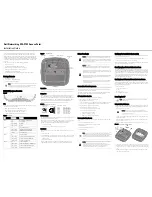
Beacon Interval:
Set the beacon interval of wireless radio. Do not
modify default value if you don’t know what it is,
default value is 100.
DTIM Period:
Set the DTIM period of wireless radio. Do not
modify default value if you don’t know what it is,
default value is 3.
Data Rate:
Set the wireless data transfer rate to a certain value.
Since most of wireless devices will negotiate with
each other and pick a proper data transfer rate
automatically, it’s not necessary to change this
value unless you know what will happen after
modification.
N Data Rate:
Same as above, but only for 802.11n clients.
Channel Width:
Set channel width of wireless radio. Do not modify
default value if you don’t know what it is, default
setting is ‘Auto 20/40 MHz’.
Preamble Type:
Set the type of preamble of wireless radio, Do not
modify default value if you don’t know what it is,
default setting is ‘Short Preamble’.
Broadcast ESSID: Decide if the wireless router will broadcast its own
ESSID or not. You can hide the ESSID of your
wireless router (set the option to ‘Disable’), so only
people those who know the ESSID of your wireless
router can get connected.
CTS Protect:
Enabling this setting will reduce the chance of radio
signal collisions between 802.11b and 802.11g
wireless access points. It’s recommended to set this
option to ‘Auto’ or ‘Always’. However, if you set to
‘None’, your wireless router should be able to work
fine, too.
















































